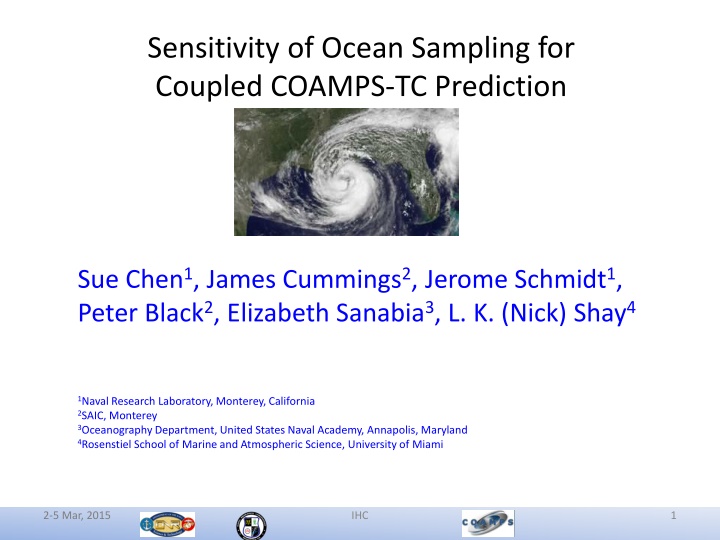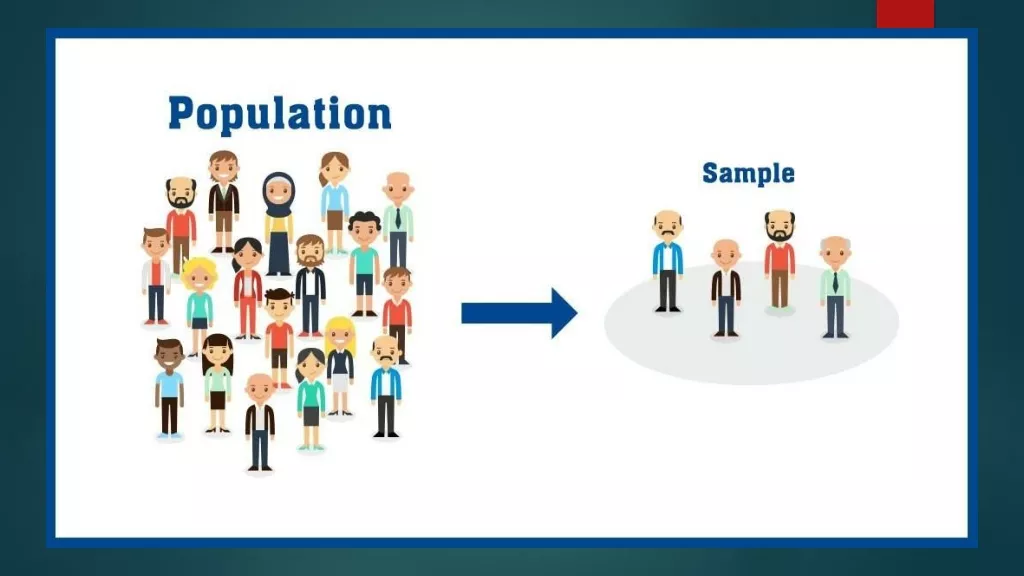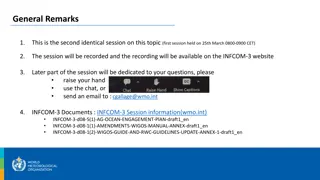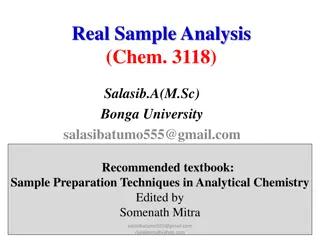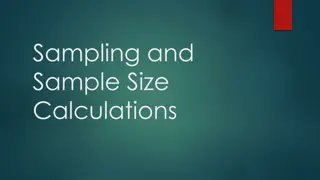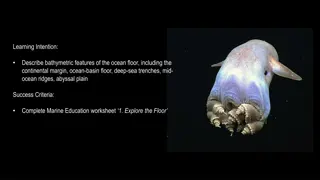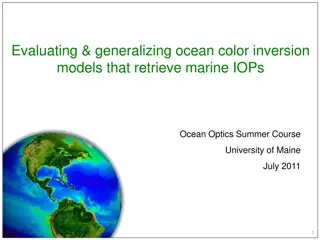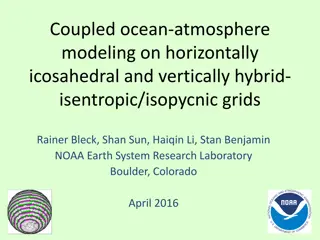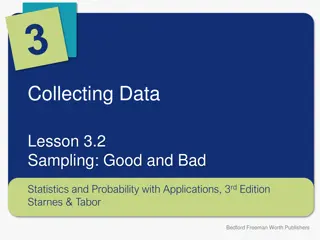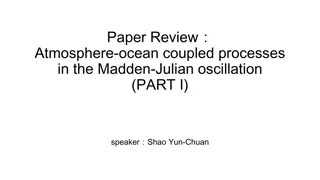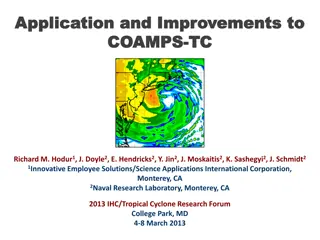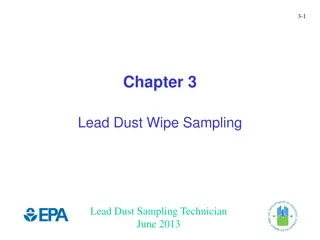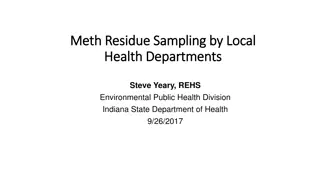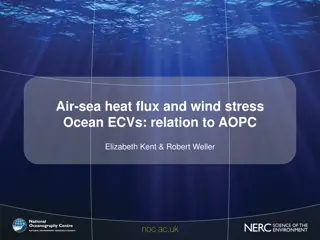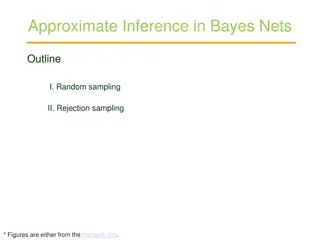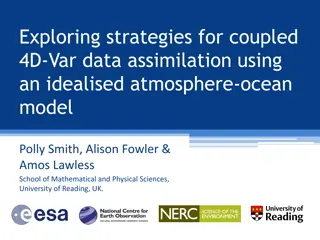Sensitivity of Ocean Sampling for Coupled COAMPS-TC Prediction Study
This study explores the optimal ocean sampling strategy for Hurricane Isaac (2012) using high-resolution in-situ observations. It investigates the sensitivity of tropical cyclone intensity change through assimilation of AXBT, AXCTD, and AXCP observations. Results show significant impact areas along the TC track and near the Florida shelf water. Various idealized optimal ocean data sampling patterns are analyzed, measuring changes in forecast error magnitude based on sea surface temperature and salinity. The study emphasizes the essential role of ocean observations in improving coupled atmosphere-ocean model predictions.
Download Presentation

Please find below an Image/Link to download the presentation.
The content on the website is provided AS IS for your information and personal use only. It may not be sold, licensed, or shared on other websites without obtaining consent from the author.If you encounter any issues during the download, it is possible that the publisher has removed the file from their server.
You are allowed to download the files provided on this website for personal or commercial use, subject to the condition that they are used lawfully. All files are the property of their respective owners.
The content on the website is provided AS IS for your information and personal use only. It may not be sold, licensed, or shared on other websites without obtaining consent from the author.
E N D
Presentation Transcript
Sensitivity of Ocean Sampling for Coupled COAMPS-TC Prediction Sue Chen1, James Cummings2, Jerome Schmidt1, Peter Black2, Elizabeth Sanabia3, L. K. (Nick) Shay4 1Naval Research Laboratory, Monterey, California 2SAIC, Monterey 3Oceanography Department, United States Naval Academy, Annapolis, Maryland 4Rosenstiel School of Marine and Atmospheric Science, University of Miami 2-5 Mar, 2015 IHC 1
Motivation Explore the optimal ocean sampling strategy for Hurricane Isaac (2012) using the NCODA adjoint Investigate the sensitivity of TC intensity change from the assimilation of the high-resolution in-situ AXBT, AXCTD, and AXCP observations 2-5 Mar, 2015 IHC 2
Idealized Optimal Ocean Data Sampling Flexible idealized sampling pattern Idealized ocean observations (20 km horizontal resolution) using data from the coupled COAMPS-TC Isaac (2012) simulations The data impact is measured as a change in the magnitude of the forecast error Warm color observations represent larger impact on reducing the forecast ocean temperature error Results indicate two areas of large observation impact on the forward quadrants of the TC for this case: Along the TC track Near the Florida shelf water 2-5 Mar, 2015 IHC 3
Idealized Optimal Ocean Data Sampling Sea Surface Temperature 101 m Sea Temperature 2-5 Mar, 2015 IHC 4
Idealized Optimal Ocean Data Sampling Sea Surface Salinity 101 m Salinity 2-5 Mar, 2015 IHC 5
XBT Temperature Impact XCTD Salinity Impact 2-5 Mar, 2015 IHC 6
SST (C): Observation - COAMPS analysis Salinity (PSU) : Observation - COAMPS analysis In-situ Observations from: Airborne Expendable BathyThermograph (AXBT) Airborne Expendable Conductivity, Temperature, Depth Profiler (CTD) Airborne Expendable Current Profiler (AXCP) ocean observations Up to -2.5 C SST and -2.9 PSU salinity changes from COAMPS analysis at 0000 UTC 25 Aug, 2012 2-5 Mar, 2015 IHC 7
COAMPS-TC Isaac simulation: 2012082612 Wind speed: 36 H Wind speed: 54 H 2-5 Mar, 2015 IHC 8
COAMPS-TC Isaac SST Change: 2012082612 36 H 54 H 2-5 Mar, 2015 IHC 9
COAMPS-TC Isaac SST Change: 2012082612 54H SST Difference Initial SST Difference 2-5 Mar, 2015 IHC 10
COAMPS-TC Isaac Intensity Change: 2012082612 COAMPS Landfall Observed Landfall 2-5 Mar, 2015 IHC 11
Summary We developed and tested a proto-type optimal sampling tool based on the 3D VAR adjoint method The idealized optimal sampling case study performed using hurricane Isaac (2012) suggests that observations in the northern quadrants of the TC have the largest impact to the sea temperature and salinity forecasts Assimilation of higher-resolution and more dense observations for the real-data simulation of hurricane Isaac improved the TC intensity forecast as well as the SST and sub-surface ocean temperature and salinity forecasts The model simulated Isaac intensity change prior to landfall between these two experiments was < 10 knots Future work includes applying the optimal ocean sampling tool to other TC cases 2-5 Mar, 2015 IHC 12
